Planning a habitat garden
Notes prepared by Bridget Kuch (Cultivating Community), 2025
Habitats in urban landscapes
A habitat is where a creature lives, where it satisfies its need for food, water, shelter and reproduction. If a creature cannot survive and reproduce in an area, it is not a suitable habitat!
Essential components of any habitat:
- Water source
- Food source (at the right timing)
- Space
- Shelter
- Means to reproduce
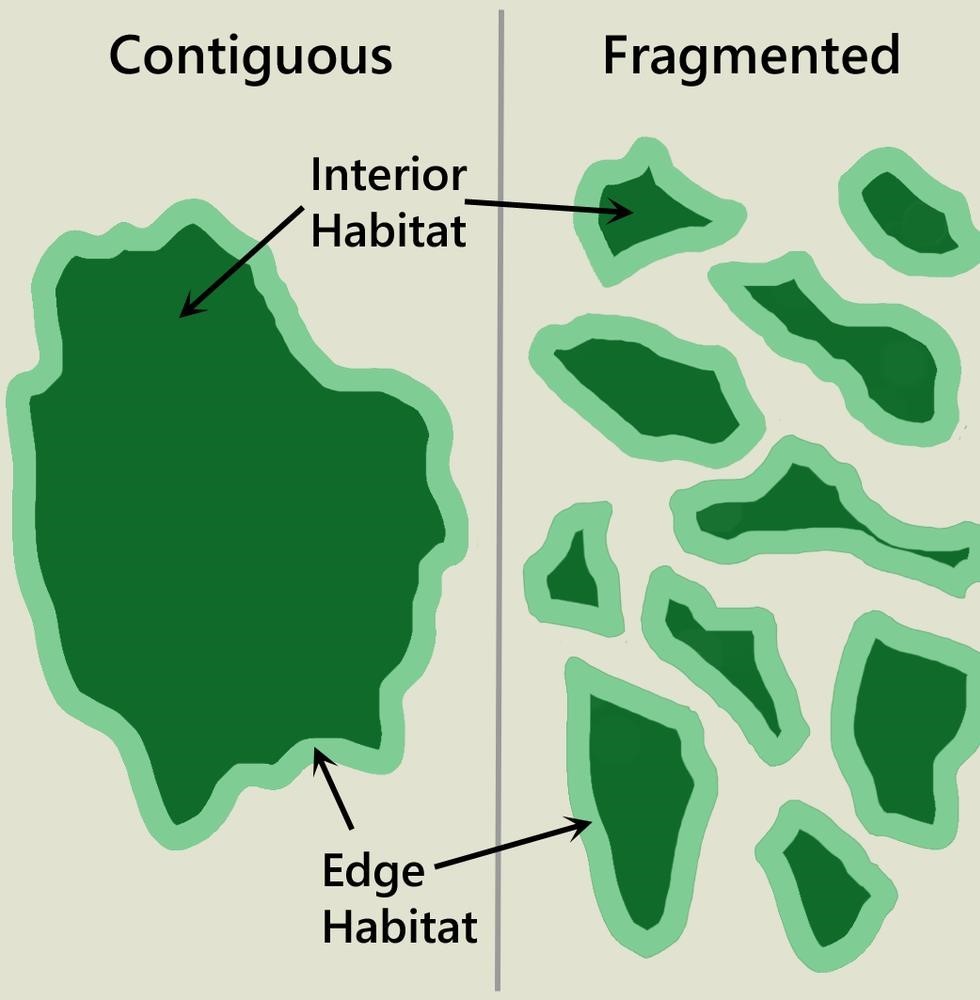
Habitat destruction and fragmentation
There are many factors that lead to habitat destruction and fragmentation. Urbanisation is one of the main factors because of increased population in city areas (moving from rural areas) and the subsequent development of landscapes to accommodate these new populations. A fragmented habitat risks the separation and destruction of a creature’s survival needs.
What is biodiversity? Why is it important?
Biodiversity refers to the diverse variety of species in a landscape including animals, insects, bacteria, fungi, plants and other species. We want diverse species and genetically diverse individuals, it is not just intrinsically valuable, but it also contributes to ecosystem services such as temperature regulation, air quality, water quality, waste decomposition, and pollination (vital for food production).
Food security depends on pollinators with over 75% of the world’s food crops (by type) rely on animal pollinators for yield and/or quality.
What can we do to help maintain biodiversity?
- Although urbanisation can threaten biodiversity, cities themselves sustain significant animal and insect life. Urban landscapes are vital for:
- boosting numbers of struggling species in regional areas
- providing space for adaptation to climate change
- migratory stop overs, and
- opportunities for enriching and educating people about species.
- Back yards, balconies and nature strips make up a significant proportion of green space available to these species.
We can help create wildlife stepping stones in our back yards, balconies and nature strips. Wildlife stepping stones are islands of habitats for animals and insects and act as connections between larger wildlife corridors (like urban parklands) which connect to even larger peri-urban habitats. These stepping stones can help provide resources to species as they pass through, or more permanent sanctuary.
Making your own habitat garden
Planning steps:
- Goal setting
- Site analysis
- Plant selection
- Soil preparation
- Weed management plan
Goals
- Year-round supply of food for species
- Want to see more ____ in my garden
- Specific species of interest (plant or animal/insect)
- Biodiversity increase
- Planting styles and personal interests
Restraints
- Time limits
- Kids/pets
- Budget
- Maintenance requirements
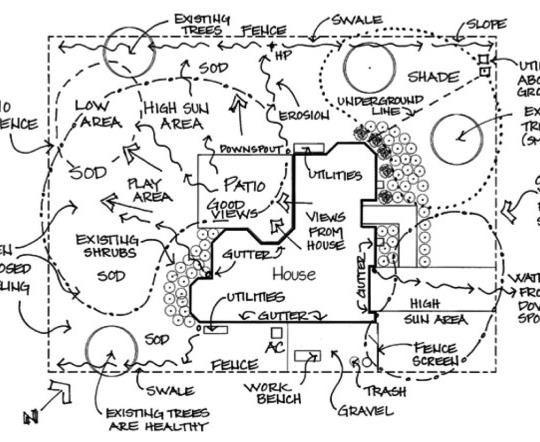
Site analysis
Questions to ask during this phase
- Orientation (North/South/East/West facing)
- Slopes
- Evidence of water pooling
- Wind
- Observations of existing vegetation (What plants are thriving here? What plants aren’t?
- Microclimates (protected areas, areas that trap heat, shady corners etc.)
Soil evaluation
- Soil colour
- Soil texture
- Soil structure
- PH test
- Compaction
- Water movement (waterlogging, infiltration)
- Soil history
- Heavy metals
A quick introduction on soil
Soil health is one of the most important factors in plant health. Our topsoil has developed over millions of years of rock weathering and plant/animal decomposition. Soil is made of mineral particles, organic matter and pore space.
Direct observation – sight
- How does your soil look? Soil colour can give us an initial indication of the health of soils. Your soil’s colour can give you an indication as to:
- How much organic matter is in the soil
- Whether your soil is high in iron or other minerals
- How prone your soil is to water logging
Direct observation – feel
- Feeling your soil can help determine soil texture and soil structure. A soil’s texture describes the proportion of sand, silt and clay particles that make up the soil’s mineral component. A soil’s structure is referring to how your soil holds itself together into soil aggregates.
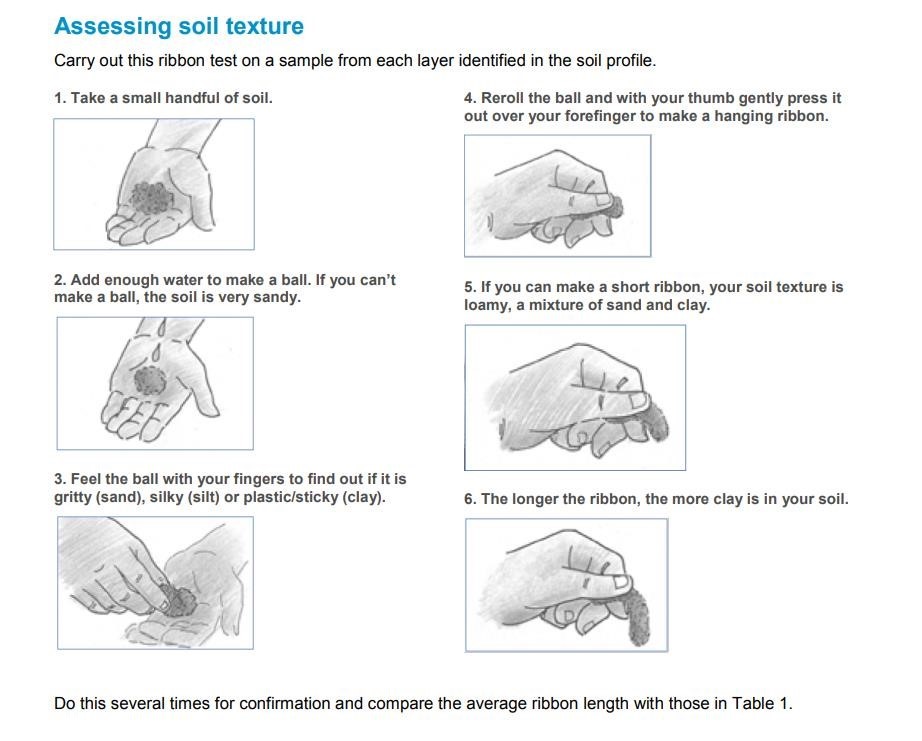
Soil texture test
- Figuring out your soil’s texture can help give you insight into many of its physical and chemical properties including:
- How well it can hold onto water
- How well it can hold onto nutrients and make them available to nearby roots
- How prone it is to compaction
- How prone it is to waterlogging

In general…
Increased sand= Increased drainage, less prone to compaction, less nutrient retention
Increased clay = decreased drainage, more prone to compaction, more nutrient retention
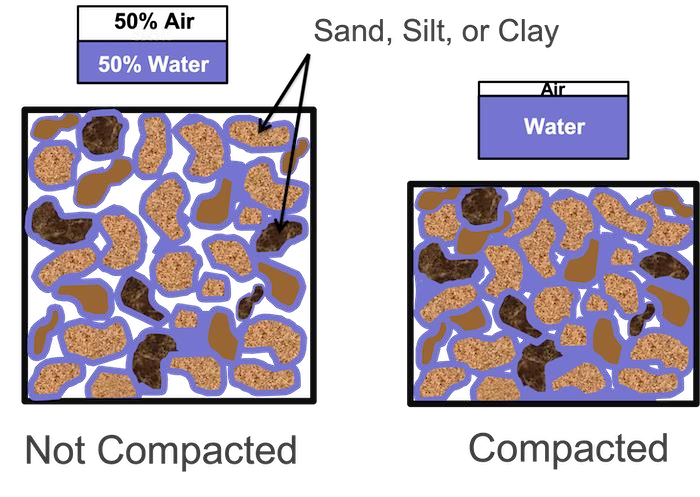
Soil compaction is related to how dense the soil particles are packed together as compacted soils stop roots from growing and restrict water and air movement.

Soil pH
Soil pH is a measure of the acidity or alkalinity of the soil and determines the availability of nutrients to your plant. Nutrient needs will depend on what you are planting. Soils can be classified according to their pH value:
- 5 to 7.5—neutral
- over 7.5—alkaline
- less than 6.5—acidic
Site history/heavy metal contamination
It’s important to consider your sites history before engaging with the soil as sites with a history of industrial use, building site, etc are at risk of heavy metal contamination. This is most important if you are considering growing food crops, but also if handling soil with bare hands. If you aren’t sure, wear gloves and wash your hands before you eat or drink. There is a free soil testing program called GardenSafe available for Victorian’s.
Plant selection
Well thought out plant selection that works with your site and soil is really important. There are a lot of plant lists out there and they can be overwhelming. Come up with some selection criteria that are important to you (goes back to goals). Ie. Size, Compaction/poor soil tolerant, Maintenance requirements, attracts x
Plant selection – where to find suggestions
There are lots of really amazing guides online which are full of plant suggestions for native focused habitat gardens. Ask your local nursery (support local) about what indigenous plants they stock and what conditions they are suitable for. Another way is to observe your neighbours and council plantings – and ask them what they have planted!
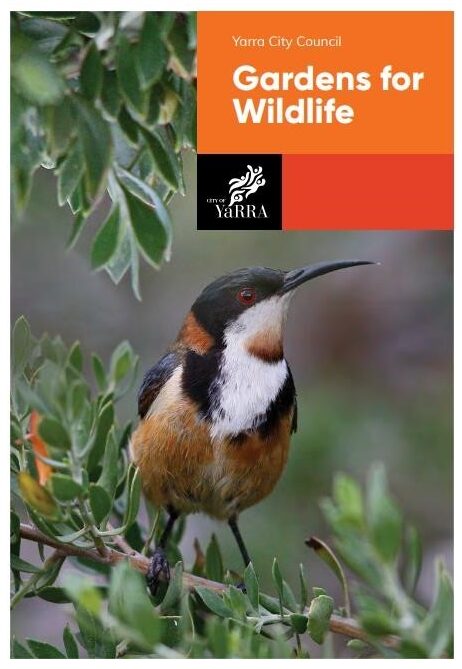
Plant selection – some guiding ideas
Pick a mixture of heights to provide a variety of foraging, breeding and sheltering resources. It is good to consider the whole food web and all habitat requirements when thinking about plant selection for example small birds like spikey shrubs for shelter. You will also want to consider flowering time when selecting flowering plants for feeding pollinators and other species. If you are planting in pots, make sure your pot is big enough to support the full growth of your plant. Indigenous is best when trying to attract indigenous species but incorporating exotic favourite species can still be beneficial (not all species are picky eaters!)
Structural elements
Structural elements are added to the site to accommodate the habitat needs for different species. These encompass all the non-plant additions to your habitat garden like rocks, stumps, leaf litter, water sources etc.
Structural elements for shelter
- Fallen logs, bark, tree hollows, rocks, twigs/sticks
- Retain existing structures and figure out where you have gaps
- Leave materials on site when you prune
- Keep precious leaf litter over lawn
- No empty earth, apply a layer of mulch
- Install nesting boxes to act as tree hallows for birds and mammals
- In smaller spaces, consider installing insect hotels to provide shelter and nesting for insects
Structural elements for water
- Raised bird baths with fresh water – add rocks or twigs to allow small birds to perch
- Shallow dishes of water at ground level for lizards, skinks, and other crawling visitors
- Consider creating a permanent pond to attract frogs to your garden
- Moist soil can provide bees and butterfly a place to hydrate
Soil preparation
It is always better to select plants that are suited to your soil rather than try to change your soil to suit your plants. Consider the results of your soil analysis:
- What do they tell you about the quality of your soil?
- What can you change?
- What can’t you change?
Soil trouble shooting
- If your soil has poor structure, add organic matter (compost, well aged manure) to help improve soil aggregates
- If your soil is compacted, consider lightly aerating it with a garden fork
- If your soil is light in colour, add organic matter
- If your soil is prone to water logging, add organic matter to help improve structure
- If your soil is too acidic/basic, consider adding garden lime or elemental sulphur (or…. organic matter!)
Weed management plan
Weeds are a part of our urban landscapes and can be a benefit (ie. Wild Mustard) however they can easily overpower native plantings if left unmanaged. Understand your site’s weed load at the start of the project and manually remove all weeds before planting, including the roots and runners. Avoid using herbicide as those on the market have huge negative ecological and health effects. Other methods to remove weeds include:
- sheet mulching
- stale seedbed technique
- solarising your weeds using black plastic over summer
Avoid disturbing the soil once planted as this can minimise new weed seeds germinating. With weed management, the work put in early really pays off in the long run!
Things to avoid in your habitat garden
- Any storebought herbicide or pesticide (even eco/organic options can be detrimental to insect species)
- Allowing your cat to go outdoors, especially at night
- If using netting to net fruit trees, ensure holes are small enough to not trap birds or bats
- Supplementary bird feeders (these can damage birds health and create dependency)
- Structural elements taken from the bush (instead use mulch from the nursery, and branches/logs from plants already in your garden)
Summary – Keys to success
- Selecting the right plants for your site that will thrive in your specific sun and soil environments
- Give ample time to evaluate and work on your site’s soil before planting
- Have a weed management plan in place to give your plants the best head start


